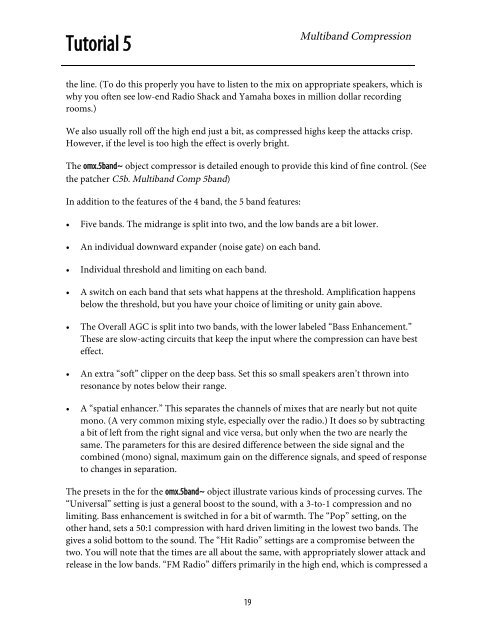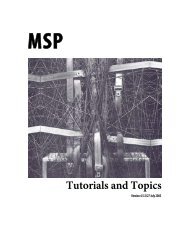MSP; "A Primer on Compression" - Peabody Computer Music
MSP; "A Primer on Compression" - Peabody Computer Music
MSP; "A Primer on Compression" - Peabody Computer Music
Create successful ePaper yourself
Turn your PDF publications into a flip-book with our unique Google optimized e-Paper software.
Tutorial 5Multiband Compressi<strong>on</strong>the line. (To do this properly you have to listen to the mix <strong>on</strong> appropriate speakers, which iswhy you often see low-end Radio Shack and Yamaha boxes in milli<strong>on</strong> dollar recordingrooms.)We also usually roll off the high end just a bit, as compressed highs keep the attacks crisp.However, if the level is too high the effect is overly bright.The omx.5band~ object compressor is detailed enough to provide this kind of fine c<strong>on</strong>trol. (Seethe patcher C5b. Multiband Comp 5band)In additi<strong>on</strong> to the features of the 4 band, the 5 band features:• Five bands. The midrange is split into two, and the low bands are a bit lower.• An individual downward expander (noise gate) <strong>on</strong> each band.• Individual threshold and limiting <strong>on</strong> each band.• A switch <strong>on</strong> each band that sets what happens at the threshold. Amplificati<strong>on</strong> happensbelow the threshold, but you have your choice of limiting or unity gain above.• The Overall AGC is split into two bands, with the lower labeled “Bass Enhancement.”These are slow-acting circuits that keep the input where the compressi<strong>on</strong> can have besteffect.• An extra “soft” clipper <strong>on</strong> the deep bass. Set this so small speakers aren’t thrown intores<strong>on</strong>ance by notes below their range.• A “spatial enhancer.” This separates the channels of mixes that are nearly but not quitem<strong>on</strong>o. (A very comm<strong>on</strong> mixing style, especially over the radio.) It does so by subtractinga bit of left from the right signal and vice versa, but <strong>on</strong>ly when the two are nearly thesame. The parameters for this are desired difference between the side signal and thecombined (m<strong>on</strong>o) signal, maximum gain <strong>on</strong> the difference signals, and speed of resp<strong>on</strong>seto changes in separati<strong>on</strong>.The presets in the for the omx.5band~ object illustrate various kinds of processing curves. The“Universal” setting is just a general boost to the sound, with a 3-to-1 compressi<strong>on</strong> and nolimiting. Bass enhancement is switched in for a bit of warmth. The “Pop” setting, <strong>on</strong> theother hand, sets a 50:1 compressi<strong>on</strong> with hard driven limiting in the lowest two bands. Thegives a solid bottom to the sound. The “Hit Radio” settings are a compromise between thetwo. You will note that the times are all about the same, with appropriately slower attack andrelease in the low bands. “FM Radio” differs primarily in the high end, which is compressed a19
















